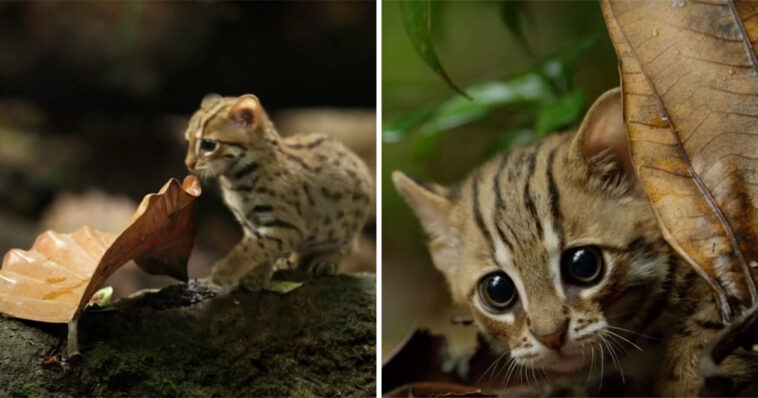Along with many other cute and charming species of the animal kingdom – such as koalas, pandas, arctic foxes, mongooses, etc. – it takes its rightful place is the rusty-spotted cat (Prionailurus rubiginosus), which happens to be the champion of the smallest wild cat in the world. They have been described by some as a smaller, ‘washed out’ version of the Leopard Cat Prionailurus bengalensis.
More info: BBC | Animal Diversity Web | (h/t: boredpanda)

The body is slim and smaller than that of a domestic cat. The coat is short and smooth, the upper part is grayish brown, with varying degrees of reddish brown, and it has spots of rusty brown. There are horizontal bars on the legs and chest; the abdomen and inside of the legs are white. Their heads are short and round, and there are two white stripes on the inner rims of their eyes. There are several rufous stripes on each cheek, and the chin and cheeks are white. The eyes are large with gray-brown to amber irises. The ears are short and round, the back is reddish-gray, and there are light spots at the base of the ears. Its legs are relatively short, and the soles of its feet are black. The average body length of the rusty cat is about 35 to 48 cm, and the tail length is about 15 to 30 cm, more rusty in color than the body, and has no markings. Due to its size, this teeny-tiny feline can be easily placed in your palm.
Rusty-spotted cats are solitary arboreal animals

They live alone in the forest, and recently in human-dominated agricultural areas. This species is considered terrestrial, but tends to be arboreal. When rusty cats were first brought to the Frankfurt Zoo, they were considered to be nocturnal because most sightings occurred at night or at dawn and dusk. They were then placed in the zoo’s nocturnal environment, but after monitoring the cat’s behavior, it was discovered that the species may not be strictly nocturnal or twilight activity. They prefer a dry deciduous forest, scrub, grassland and rocky areas.
There are 10,000 rusty cats in the wild, and this species is listed as a vulnerable species by the IUCN: International Union for Conservation of Nature

Like other wild cats, the number of rusty cats is declining, mainly due to habitat loss and hunting pressure (due to their fur and even food in certain parts of their habitat). There are reports that they have been domesticated due to their size and intimacy. In fact, rusty spotted-cats are very active and playful.
Danielle Miles, A Nevada wildlife researcher working on responses to wildlife from conifers, who is currently pursuing a Ph.D. and also teaching courses (such as Conservation Biology), wrote for the Animal Diversity Web on the rusty-spotted cat during her undergraduate years at university: “The way that the Animal Diversity Web used to work was from a list of species that needed to be updated. Then, through approved universities and advisors, people could volunteer to write up the page for the species needed. At the time, I was an undergraduate researcher working in two labs, one on Spotted Hyenas and one more generally on carnivore evolution. So, when I saw that the Rusty-spotted cat was one of the species that still needed an account, I took the opportunity.”
Many people on the Internet are interested in whether this cute animal can be tamed. However, Miles explained if they really should be brought into people’s homes:

“In short, no. An easy way to predict the outcome of people buying rusty-spotted cats is to look at the fate other species have had to face from these scenarios. How many other wild cat species, bears, alligators, and the like have had domestication attempts only to land hundreds to thousands of animals in rescues living incomplete lives as they cannot re-acclimate to a free life.”
“Perhaps the closest examples to the Rusty-spotted cat to draw upon are actually lemurs and other small primates.” continued Miles. “People are attracted to the idea of species like these as pets because they are cute and intelligent, and their size makes them seem manageable and less dangerous. Yet, the truth is that these situations do not work out and the animals end up being euthanized or if lucky, put in a rescue like Lemur Island.”
“A focus on preserving their natural habitat and protecting more space from development is key”

“There are no specific conservation plans targeting just the rusty-spotted cat that I am aware of currently, but a focus on preserving their natural habitat and protecting more space from development is key. Protections for unaltered landscapes would not only benefit the Rusty-spotted cat into the future but would provide habitat for all species in those ecosystems, some of which has surely not yet been discovered.”
“The threats to rusty-spotted cat populations are the same that have caused declines in many species across terrestrial landscapes—habitat loss and limitations to their natural ranges and movements,” explained Miles. “As human populations continue to skyrocket, especially in India, developed areas continue to grow and sprawl into areas that were previously forest habitat. In addition, the spread of roads and agricultural land has led to increased sightings of Rusty-spotted cats in more human-dominated landscapes.”
“However, I do think that the growing intrigue for the Rusty-spotted cat can be put to good use for conservation,” explained Miles. “These are especially fascinating creatures due to their size and relative novelty to the general public. I would encourage anyone who has now found themselves enthralled with the Rusty-spotted cat find helpful ways to fuel their passion.”
Miles concluded that another option would be a resource for local zoos and animal rescue. Rusty spotted cats are relatively rare, but certainly people will find that devoting time and energy to these organizations is a wonderful learning experience and a much more rewarding task.


